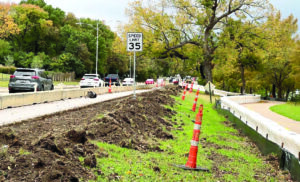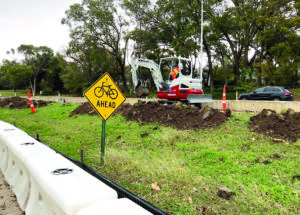By Andy Morgan
Drivers on Garland Road going south near the Dallas Arboretum — and those on foot or bike on the nearby White Rock Lake Trail — can expect traffic and trekking woes until at least fall 2025.

Photos by Chris Morgan
In early November, the Texas Department of Transportation (TXDOT) began replacing a chain of temporary barriers along Garland Road with permanent ones. Once that’s done, the City of Dallas will close the existing trail and reroute it — possibly onto Garland Road. The goal is to fix a troubling erosion issue along the lake shore.
Drivers along that section of busy roadway can’t seem to get a break from construction hassles. Just this year, TXDOT completed the multi-year realignment effort of the Garland, Grand and Gaston intersection.
And earlier this year, the city installed a chain of interlocking, water-filled barriers atop the curb from about St. Francis Ave. to just west of San Rafael Dr. The barriers were a response to at least two accidents. Vehicles careened off Garland and onto the trail.
“The erosion is horrible and needs to be fixed,” said Donna Wortman, a lifelong resident of East Dallas.
“But I don’t think it’s a good idea to cut off another lane going south. The big problem is during rush hour. Is it possible for the crews to work in the early morning and at night? My big concern is the speed of the traffic, particularly around that corner there.”

“The goal is to install permanent concrete barriers between the road and the White Rock Lake Trail,” TXDOT spokesperson Tony Hartzel said. “The closure of the outside, southbound lane is necessary to give our crews room to work.”
He said the new roadway barriers are standard — 32 inches high and made of concrete. The barriers will be anchored as close to the road’s curb as possible.
Once the TXDOT barrier project is completed in early spring, the city’s Park and Recreation Department will kick off an erosion-control initiative along the same stretch of White Rock Lake.
Chris Turner-Noteware, assistant director of Dallas’ Park and Recreation, said the city has been evaluating erosion next to the trail for about one and a half years. She said the trail is safe and not in “imminent threat of failure.”
Turner-Noteware said the city is reviewing design firm proposals now. The actual design work is expected to take about three months.
It will take another three months to find a construction firm.
“We should hopefully be ready to start (construction) right around March or early spring,” she said. The project should take about six months, she said. That means the earliest it could be done is September 2025.
The big question for hundreds of cyclists, runners and walkers is what happens to the trail during construction.
The city is mulling two options. One is to use the outside, southbound lane of Garland, the same lane that’s currently blocked off for the barrier construction. That means traffic whizzing down Garland will be behind a temporary barrier and a few feet from trail trekkers.
Turner-Noteware said the city is still formulating a second option for the trail but isn’t ready to announce that solution.
She is, however, ready to talk about why yet another construction project is necessary in the same area of East Dallas. “The erosion is trying to basically take out the shoreline,” she said. “It’s basically a function of wave action against the shore. What we think happened in this case is that there was a low foundation that used to be about 18 inches tall. It was probably constructed at what was then the water’s edge.”
Fluctuating lake levels are causing water to flow over the low foundation and creating the erosion issue, she said.
The city may install sheet piling, a wall material that will be driven about 20 feet below the edge of the water line, she said.
Once the shoreline is protected, the city anticipates having to rebuild part of the lake trail. “We’re just not sure right now,” Turner-Noteware said. “We’re going to have to see what things look like after the construction gets done.”
